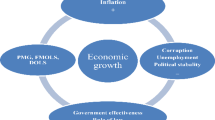Summary
This paper describes a theoretical and empirical study of the Japanese macroeconomy that focuses on the role of predetermined nominal wages in the relation between monetary policy and aggregate output. The main features of the model are that nominal wage rates set at Shunto are equal to rational expectations of the nominal wage rates that would be consistent with target levels of real output and that firms determine employment and output by equating marginal productivities to real wage rates. The essential implication of the model is that the current deviation of aggregate output from its target level depends only on innovations in inflation and productivity since the last Shunto. The equation derived to implement the model empirically relates current aggregate output growth in a precise way to Past values of output growth and inflation since the last Shunto and includes an explicit specification of a white noise error term. The results of econometric analysis of this restricted model equation are consistent with the hypothesis that nominal wages, predetermined according to Shunto with rational expectations, are important for the determination of real aggregates.
Similar content being viewed by others
References
Blanchard OJ, Summers L (1986) Hysteresis and the European unemployment problem. NBER Macroeconomics Annual
Boschen JF, Grossman HI (1982) Tests of equilibrium macroeconomics using contemporaneous monetary data. Journal of Monetary Economics 8
Fischer S (1977) Long-term contracts, rational expectations, and the optimal money supply rule. Journal of Political Economy 85
Grossman HI (1983) The natural-rate hypothesis, the rational-expectations hypothesis, and the remarkable survival of non-market-clearing assumptions. In: Carnegie-Rochester Conference Series on Public Policy, vol 19
Hall BH, Hall RE (1980) Time series processor: version 3.5, user's manual. Stanford, California
Komiya R, Yasui K (1984) Japan's macroeconomic performance since the first oil crises: review and appraisal. Carnegie-Rochester Conference Series on Public Policy, vol 20
Montgomery E, Shaw K (1985) Long-term contracts, expectations, and wage inertia. Journal of Monetary Economics 16
Shimada H (1983) Wage determination and information sharing: an alternative approach to incomes policy? The Journal of Industrial Relations 25
Suzuki Y (1981) Monetary control and anti-inflation policy: the japanese experience since 1875. Bank of Japan Discussion Paper No. 8
Taniuchi M (1982) Prior monetary expectations and output determination: a study of the japanese economy. Unpublished dissertation, Brown University
Author information
Authors and Affiliations
Additional information
Support for this research included a grant from the Joint Committee on Japanese Studies of the Social Research Council and the American Council of Learned Societies with funds provided by the National Endowment for the Humanities and the Ford Foundation and a grant from the National Science Foundation (SES-8408873). Jun Il Kim and Michelle Garfinkel provided excellent research assistance. We acknowledge the helpful comments of anonymous referees.
Rights and permissions
About this article
Cite this article
Grossman, H.I., Haraf, W.S. Shunto, rational expectations, and output growth in Japan. Empirical Economics 14, 193–213 (1989). https://doi.org/10.1007/BF01972390
Received:
Revised:
Issue Date:
DOI: https://doi.org/10.1007/BF01972390




